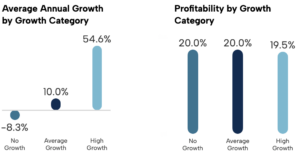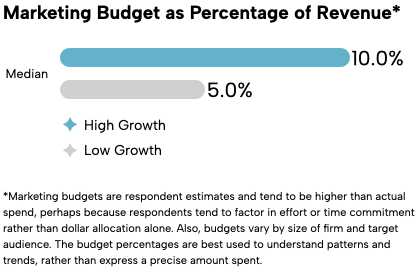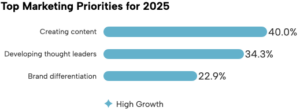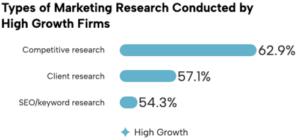Hinge is excited to announce the release of the Technology & Software edition of the 2025 High Growth Study. We launched the High Growth Study ten years ago, and countless firms have used it to understand how the best-performing firms build and maintain their competitive edge. 149 technology and software companies participated in this year’s industry breakout report. They represent over $26 billion in combined revenue and 206,000 employees. As you can see in the chart below, the sample included firms of all sizes.

One group of these firms significantly outperformed the others. We call these high-growth firms, which we define as firms that achieve at least 20% compound annual growth rate over a three-year evaluation period.
In the five charts below, we explore five key marketing characteristics of these exceptional companies—including where they focus their limited time, attention and dollars. You can learn much more about these organizations and how you can emulate their success in this year’s technology and software industry report.
Before we dive in, a note about the marketplace: We collected our data late in 2024, but before the election or the changes that are sweeping across the marketplace today. High-growth firms, however, have an excellent track record of success even in uncertain times. So the findings in this report represent a set of fundamentals that can work in almost any economy.
Let’s dive in.
5 Marketing Features of High-Growth Technology & Software Firms
1. They Grow More than 5X Faster
The high-growth group grew at an astonishing rate of 54.6%—almost 5.5 times faster than the average growth group. This represents a 16-point increase over the previous year. High-growth company profitability was a respectable 19.5%—half a percentage point below the average- and no-growth groups. Whether they are growing or not, most technology businesses today are generating healthy profits.

2. High-Growth Companies Invest Twice as Much in Marketing
Most technology and software companies spend about 5% of their overall revenues on marketing. High-growth firms, however, invest twice that amount. What are they spending on? Mid-size and large high-growth firms have much larger marketing teams, for one. They also tackle more marketing priorities and are more likely to have achieved the highest level of digital maturity. The extra dollars appear to deliver dramatically faster growth.

3. They Know Which Marketing Techniques Work Best
Below is a list of the six marketing techniques used most frequently by high-growth technology and software companies. If you study this list, you’ll notice a couple of themes. First, they tackle networking on two fronts: online and in-person. Building personal connections is a classic way to establish trust and move people down the marketing funnel. Second, thought leadership is a major thrust of their marketing, including public speaking and promoting written and recorded material in social media. In fact, thought leadership is their top priority. Third, these firms use a balanced mix of online and offline marketing techniques. In our experience, a 55:45 ratio of online to traditional techniques is ideal.

4. Creating Content Is Their Top Priority
As we mentioned above, high-growth companies have made thought leadership their highest priority. How do we know? They told us. The chart below lists these organizations’ top three marketing priorities for this year. Leading the way is creating content. Content can include a wide range of things, from blog posts and journal articles to books and executive guides to videos, webinars and speeches. Second on the list is developing thought leaders. At Hinge, we call these industry stars Visible Experts®. One very important way these experts build their reputations and visibility is by writing and speaking—in other words, creating content. The third biggest priority for these firms is differentiation. High-growth firms tend to be well differentiated, which gives them real advantages over their poorly differentiated peers.

5. More than 9 Out of 10 High Growth Firms Do Research
All but 8.6 of high-growth firms conduct research. That’s important because research provides critical, highly relevant intelligence they could get no other way. Information they can act on and use to gain an advantage over their competitors. The type they do most often is competitive research. In an industry where innovation is the name of the game, it’s critical to know what your rivals are up to. Client research (also called audience research) is the second most common. This type of research is especially valuable because it allows companies to monitor the changing habits and preferences of their target buyers. Leadership can use this intelligence to inform their strategy, products and services, and marketing. SEO research involves identifying what words and phrases your audience searches for, determining which are most relevant to your organization and using the results to optimize content and service pages so they are more likely to rank well on search results pages and in generative AI searches (such ChatGPT, Gemini, and Anthropic).

How to Learn More
We hope these findings help you understand today’s marketing landscape a bit better and spark a few ideas to adjust your marketing strategy.
These five insights, however, just scratch the surface. To learn more about the marketing habits of the fastest growing technology and software firms, purchase the full industry report. The 55-page report goes into much more detail on these and many other eye-opening findings. It also provides easy-to-understand guidance to put the data into practice.


